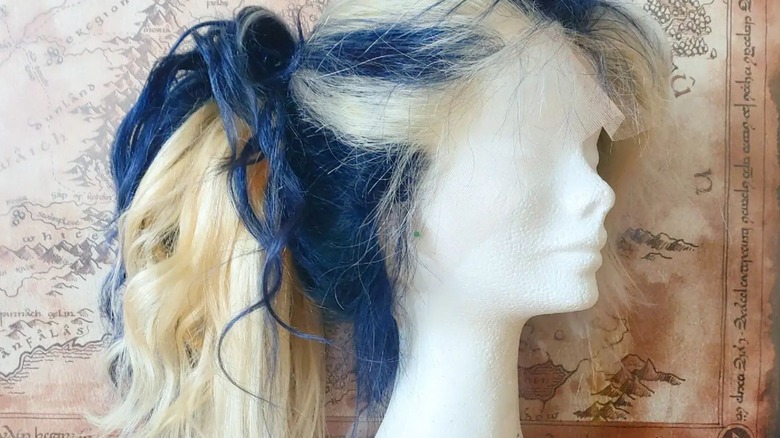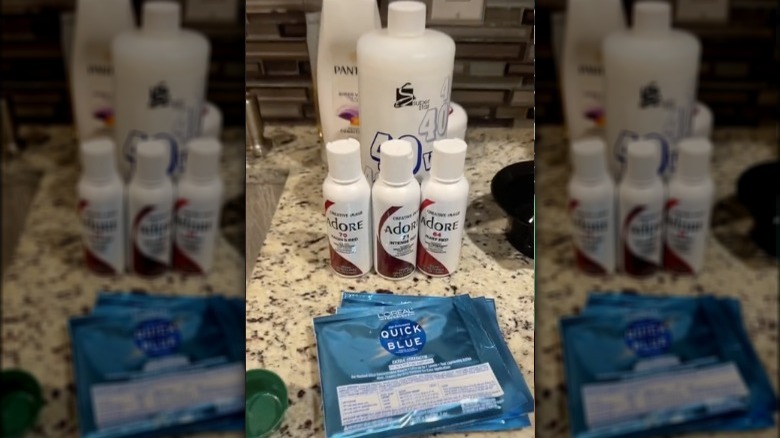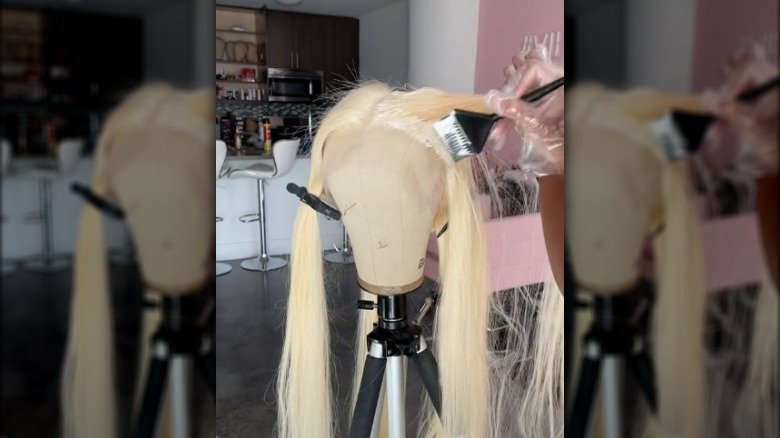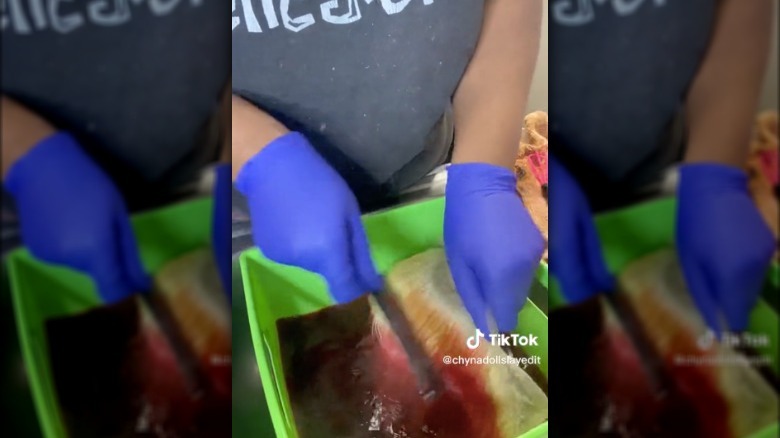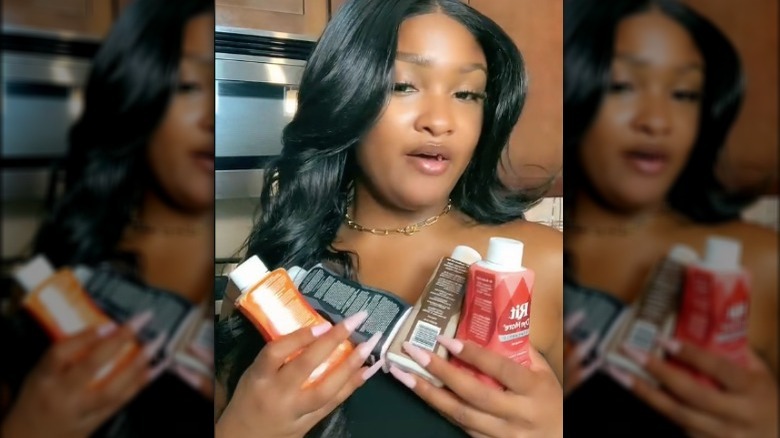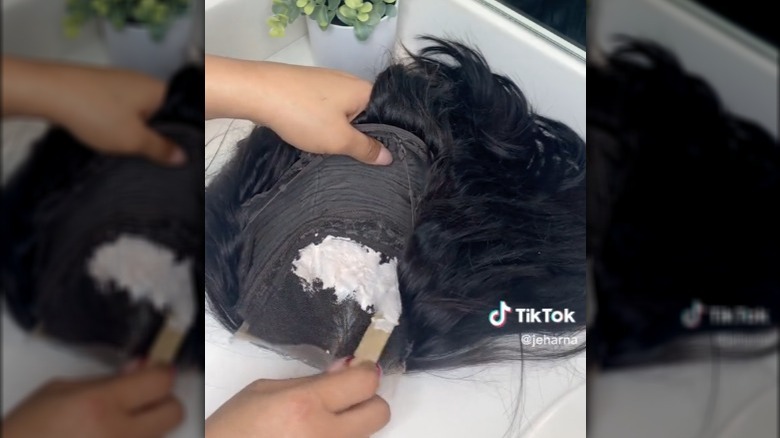Tips For Dyeing Your Wig At Home (& The Mistakes To Avoid Making)
It's easy to get bored with your hair, especially when you're seeing everything other people are doing with theirs. From face-framing highlights to all-over color, when you see someone with a fresh new look, that hair jealousy can easily set in. Unfortunately, bleaching and dyeing your hair can be incredibly damaging. The harsh chemicals can break down bonds, causing breakage and dryness. And if you're one who likes to change up their look often, constant dyeing can be a problem for your hair health. The solution: wigs.
Wigs can allow you to experiment with color and play around with trends without putting your own hair at risk. There are many stylists who will dye your wig for you, but if you're a DIY person, you can take on the tasks yourself with the right tips. No, you don't have to be a stylist, but you should have a good idea of the basic process of bleaching and dyeing hair. Once you grasp the process, you can change up your look as often as you please.
Gather your tools
Dyeing your hair is not something you're going to want to wing. Once you start the process, it's not recommended to stop in the middle, so it's important to have everything you're going to need to dye your hair and have enough of it. Firstly, if your wig is dark and you want to go lighter, you will want bleach and developer. How much bleach depends on what you want your final result will be. You'll need more for all-over color than for a few highlights. And if the wig started out black, you might need to bleach it twice to get the right amount of lift. Or, you can buy a blonde wig and skip the bleaching process.
Consider getting the large tubs of hair bleach rather than the small, individual packets. With developer, you can choose 20, 30, or 40 volume and it depends on the level of lift. 20 volume lifts one or two color levels, 30 volume lifts two to three, and 40 volume lifts four levels. Again, it depends on how light you want your final results to be.
You'll also need the dye color you're planning on dying your hair. You can use a box color from the drugstore or look for something a little more high quality from beauty supply stores. Beyond dye and bleach, you'll want color bowls to mix up the dye, brushes to apply it, gloves to protect your hands, and towels you don't mind messing up.
Set aside time
When you go to a salon for a color treatment from a trained professional, the process can take hours. Expect dyeing your wig to take just as long when you're doing it at home. Assuming you're bleaching and dyeing the entire wig, the time of each step can look a little like this.
Thoroughly applying the bleach can take between 15 and 20 minutes, sometimes more, depending on how long the hair is. You'll have to wait 30 minutes for the bleach to develop before washing it out. Applying the hair color can take another 15 to 20 minutes for one all-over color, but if you're also adding highlights, it can take closer to 40 minutes to an hour. Then the wig has to sit for another 30 to 40 minutes before being washed out.
All in all, the process can take, on average, three hours, but that estimate can change depending on the length of the hair, the density of the wig, and the hair color look you're after. If you're starting with a blonde wig, it can knock some time off since you won't have to go through the process of bleaching. It's recommended to choose a day where you can dedicate uninterrupted time to work on your wig. Give yourself more time in case the process goes slower than expected.
Choose your method
Before dyeing your hair, you should have a plan of attack. Looking at an inspiration image is not enough; you'll have to do a little research on techniques to achieve the color style you want. Use the inspiration image to find the technique you should be using to dye your hair, and then look up video tutorials on how to achieve it. This is especially important for more complicated processes like balayage or highlights, so you might want to follow a tutorial while you're dyeing.
Dyeing a wig one color, however, is a much easier process in general. For that, you can brush the color on all the strands with your hands or the brush, or you can use the water method. With this method, you'll want to fill a large bucket, tub, or another container with hot water and mix in the hair dye. Then you'll want to place the hair in and allow it to sit to soak up the color for a few minutes. Remove the hair, wash out the excess color, and dry. The water method is a much quicker way to dye your wig, but it's also important to remember that it'll dye everything, including the lace. You'll also have less control of color placement, so it's only a good option if you're looking for all-over color.
Know what kind of hair the wig is
Whether you're buying a new wig to dye or want to refresh a wig you already have, it's important to know whether the hair is human or synthetic. The type of hair is going to affect how you dye the wig. With human hair wigs, you can treat them like the hair on your head; they can take bleach and dye. But because they're human hair, the strands can dry out easily. Bleach and dye can do a lot of damage to the cuticles and bonds in the hair and without the natural oils from a scalp, as the hair growing from your head receives, your wig can dry out much easier. It's important to use reparative and restoring products and oils to keep the wig moisturized.
However, the process is a little different when it comes to synthetic hair. Unlike human hair wigs, synthetic wigs use fine plastic fibers to create the strands. Powder bleach and developer, when used on synthetic hair, can cause damage. The wig can lose its texture and may not stay in good condition for as long as it should. The bleach and developer can even melt the hair if not applied correctly. Because of this, it's recommended to choose a wig that's already a lighter color, like blonde, white, or silver, if you want to DIY-dye a synthetic wig. Using traditional hair color may not work that well on synthetic hair. Instead, use a craft dye made for synthetic fibers.
Don't forget to bleach the knots
One mistake that novice wig dyers make is not bleaching the knots. When you have a lace wig, the hair strands are attached to the lace with little tiny knots. Even if the wig has high-quality or invisible lace, the knots can still be visible. When knots aren't bleached, they can look like little black dots rather than hair growing out of your natural scalp. If you don't bleach the knots, it can ruin the illusion of your wig looking like your natural hair, especially if you bleach and dye your hair a lighter color.
To bleach the knots, apply some of the bleach to the underside of the lace. Using a brush, gently swipe across the lace. If you press too hard, the bleach can come through the lace and dye the roots of the hair. This may not be a problem if you're dying your whole wig, but if you plan on leaving the roots or the hair dark, then this can result in patchy or discolored spots. Leave the bleach on for 15 to 20 minutes, then rinse well and use purple shampoo to remove brassiness.
